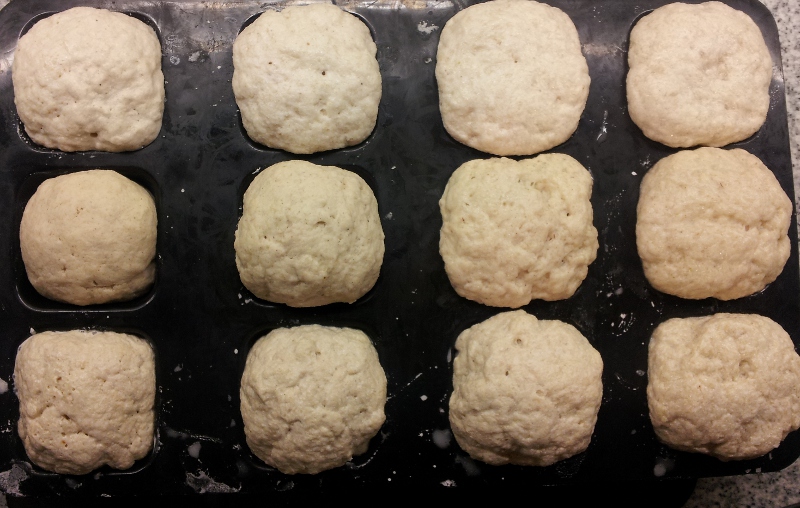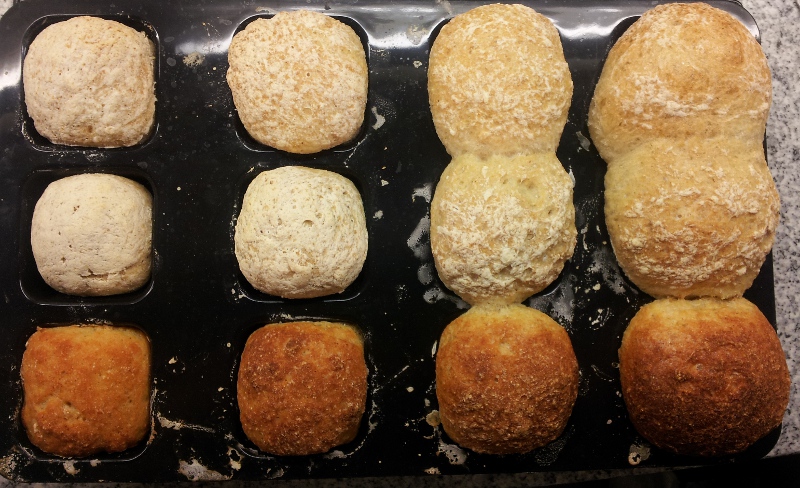
Warning - this contains lots of photos
I outlined the experiments I wanted to undertake with regards to GF baking in a previous post and here is a brief personal log of the first steps.
I baked gluten free breads with a mix of tapioca flour, potato flour and five other flours using instant yeast as rising agent and psyllium husk as gelling agent.
The psyllium husks have been soaked with 20g water per g Psyllium.
For each of the "main" flours (making up 60% of the total flour, the rest are the starches) the amount of psyllium has been varied and hydration has been adjusted to give the doughs a similar feel as far as possible.
The details of the bakes are in a google sheet here:
https://docs.google.com/spreadsheet/ccc?key=0AkcYHhPxccKtdG5aRV96RVY3TUkzdWM1R0tWcndmaXc&usp=sharing
The sorghum was a flour from TRS, the millet was a GF certified flour from Infinity Foods and the others were freshly milled.
The breads were baked at 210C for about 40 minutes.
Now to the results:
Quinoa gets the best marks in terms of color, Sorghum in terms of handling, consistency and crumb. Rice bread was surprisingly light and tasty.
The amount of psyllium has a great influence on the handling qualities of the dough, there is a fine line between yielding a pliable and a dough that feels more like jelly.
Because Psyllium attracts so much water the amount of Psyllium also hugely determines the final hydratiuon of the dough.
1. Buckwheat:
With 2% Psyllium / 90% Hydration and 4%Psyllium / 110% Hydration the crumb was pleasant and the taste strong but not overpowering. Above 110% Hydration the taste became watery.
The batch after "shaping":

After baking (the same labels apply):

And here the crumb:

2. A batch with brown rice, sorghum and quinoa, after shaping:

After proofing (the same labels apply):

After baking:

And here the crumb:

3. Millet
This was the first of the batches, and I might have overproofed a bit.
The shaped batch:

After proofing

After baking

And here the crumb:

The 4% Psyllium Millet loaf is agreeable. I might repeat this with less hydration, although I must say that for me millet is the clear looser in terms of texture, taste and handling.
- Juergen Krauss's Blog
- Log in or register to post comments
Wow!
I am impressed with your photos and how well you kept up with all of your variations. I tried baking a GF loaf for a neighbor but was not at all pleased with the results. I haven't ventured back into that arena again but if I do I now know where to look for what works.
Thank you for sharing your results and for ALL of the photos.
Take Care,
Janet
and I found it very unsatisfactory.
I think that using Psyllium husk as a gelling agent makes a huge difference, PLUS the right balance of starches and taste carrying flours. I am very greteful for the experiences offered here by Gluten Free Gourmand and Laura T
Arspistorica's blog is also a magnificient resource for GF sourdough.
Janet, I start seeing GF bread as an extension to my repertoire, not anymore as something weird and different.
My very critical son enjoyed the test bakes, especially the Sorghum and Buckwheat.
Best Wishes,
Juergen
Hi Juergen,
Thanks for posting this great matrix of experiments! You covered a lot of ground here, and, although I have not done a lot with gluten-free breads personally, you've done a favor for everyone who does and saved them a whole lot of work. The buckwheat with 6% psyllium seems to have a nice looking crumb. I look forward to more tasting results.
-Brad
Brad, I enjoy very much trying such things systematically - one of my earliest posts here was a similar study of under/overproofing. I should revisit that one at some point.
The Buckwheat is great, the 6% version looks stunning but the 4% tastes better - less watery.
I managed to get a Sorghum sour going (ferments like crazy) and tomorrow I'll try my luck with a Sorghum Sourdough, psyllium and hydration based on my experiences here.
Thank you for your interest,
Juergen
We appreciate your efforts to showcase your GF bread results, Juergen! That is an excellent detailed piece of work ,very neatly explained.
Amazing results! The quinoa one is the best looking. Those are exotic flours i've never tried before.
-Khalid
Khalid, this was a first for me, too, on many levels.
I love Quinoa, but never baked with it. Never used or heard of Sorghum or Psyllium before.
Thank you very much,
Juergen
Love your experimental designs, and am following up on the quinoa, sorghum and brown rice candidates. IgG4 testing for my food sensitivities indicated that all cereal grains are out as well as buckwheat. Go figure on the last one? Did you use potato starch or potato flour? These two ingredients are very different in baked goods.
John
Hi John,
Unfortunately I'm not getting to experiment much recently, but I am regularly making rice sourdough, which proves to be popular.
I am using potato starch.
On my experimental mind is to reduce the amount of starches, and introduce rice scald ...
Happy Baking, and Best Wishes,
Juergen
Juergen:
What procedure do you use to shape the dough after bulk fermentation? Since there is no gluten, I'm not sure of the utility of shaping.
Also, do you degas during shaping for a second rise?
I'm going to follow your recipe to make GF bread for my wife.
Regards-
Dave
Hi Dave,
Thank you for your interest.
Which bread exactly do you want to make?
I got somewhat stuck with my experiments, but have formulas for rice sourdough and quinoa sourdough breads that work well.
I am making about 2Kg rice sourdough bread weekly, as this bread has developed quite a following. Great texture and taste, unlike so many GF products.
The more specific things: Knead the dough until it gets smooth. Think of "hydrating through kneading" (the Germans have a term for that: Quellknetung).
When shaping keep in mind the idea of surface tension, but try not to deflate or tear the dough. I am sure a bake without shaping would work, but I haven't tried it.
Looking forward to hearing from you,
Juergen
Hi,
My sourdough is stoneground brown rice alone. From www.buywholefoodsonline.co.uk, very good quality (I am in the UK).
Tried Doves Farm (25Kg), but the flour was off and I couldn't get past a quality control lady for a refund. Shame.
To start the sourdough I use rice flour alone, but here the important bit: I can't get it going with bought flour - I use home-milled brown rice and that works like a charm.
Another important bit: I bought a ph-meter to make sure my sourdough is below pH 5, so that I won't get problems with bacillus cereus.
The flour mix is 60% rice, 40% starches.
No experiments with 100% rice or scalds. Psyllium is really great stuff.
Here a photo (500g tinned loaf)
This loaf is 9 days old! No signs of mold, toasted still a delight.
Good luck with your explorations
Jürgen